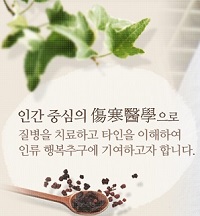『傷寒論』 辨病 診斷體系에 근거하여 麻黃湯 투여 후 호전된 부종 증례 1례
A Case Report of Edema Treated by Mahwang-tang based on Shanghanlun Provisions
왕인호 (두리한의원)
황보민 (대구한의대학교)
최해윤 (대구한의대학교)
Abstract
Objective : The purpose of this study was to report the improvement in a patient with edema treated by herb medication based on Shanghanlun provisions. Methods : According to ‘A disease pattern identification diagnostic system based on Shanghanlun provisions (DPIDS)’, a patient was diagnosed with Taeyang-byung, no. 46 provision and was administered with Mahwang-tang herbal medication for 30 days. The Numeric rating scale (NRS) was used to estimate the response. Results : The NRS score changed from 10 to 1 and the edema disappeared by 46th provision of Mahwang-tang selected according to Shanghanlun provisions. Conclusions : This case report suggests that the two words in the 46th provision of Shanghanlun, ‘陽氣重, 無汗’ (Yang qi heavy, Absence of sweating) indicate a close relationship between photosensitivity and absence of sweating, thereby affecting edema in this case.
- keywords
- Mahwang-tang, Edema, Shanghanlun, Disease Pattern Identification Diagnostic Systen based on Shanhanlun Provisions (DPIDS), Herbal medicine, Photosensitivity
참고문헌
1. Jeong DW, Lee SY. Edema. Korean Journal of Fam Med. 2010;31:829-36.
2. Isselbacher KJ, Braunwald E, Wilson JD, Martin JB, Fauci AS, Kasper DL, et al. Harrison’s pronciple of internal medicine. Jeongdam. 1997:200-5.
3. Ely JW, Osheroff JA, Chambliss ML, Ebell MH. Approach to leg edema of unclear etiology. J Am Board Fam Med. 2006;19:148-60.
4. Kim DI. Clinical course of idiopathic edema common in women. Dongwon journal. 1997;10:281-305.
5. Lee SJ, Lim JE. A diagnostic system and clinical application based on six meridian patterns and provisions. Seoul:KMediACs publishing house. 2013.
6. Kim DD. A study on the naming of 'A diagnostic system based on Shanghanlun six meridian patterns and provisions' and suggestion. Journal of Korean Medical Association of Clinical Sanghan-Geumgwe. 2013;5(1):19-29.
7. Rho YB, Lee JH, Ha HI. The fundamental meaning of Mai and Shanghanlun provisions based on Paleography. Journal of Korean Medical Association of Clinical Sanghan-Geumgwe. 2015;7(1):1-14.
8. Park SY, Lee SJ. A case report of ptting edema treated by soshiho-tang based on Shanghanlun provisions. Journal of Korean Medical Association of Clinical Sanghan-Geumgwe. 2017;9(1):37-45.
9. Lee SI. Comparison of Shanghanlun. 1st edition KMediACs pulishing house. 2015:197.
10. Medical education research institute. Cliinical test by sysptom. Seoul national university press. 2002:183-7.
11. Mach R, Fabre J, Muller A, Neher R, Borth R. Idiopathic edema caused by sodium retention with hyperaldosteronuria. Bull Mem Soc Med Hop Paris. 1955;71:726-32.
12. Baek TH. A study of dieteic theraphy on the edema. Korean Journal of Herbology. 2010;25(4):151-60.
13. Mark H B, Robert B. The Merck manual. Hanuri. 2003:886-9.
14. Moon JJ, Ahn GS, Kim SH, Park JH, Kim DH, Choi DY, et al. Sanghanlunjeonghae. Publicaton Haneuimunhwasa. 2010:176-82,329.
15. Lee JH, The illustration of important hebal formula. Publicatons Euibang. 2004:276-7.
16. Shin YS, Jeong JK, Lee SI. A analysis of clinical cyudies on Mahwang-tang. Herbal Fomula Science. 2019;27(1):87-100.
17. Ha YS. The etymological dictionary of chinese character. Doseochulpan3. 2015:428.
18. Kim DD. A case report of panic disorder treated by Jukyeopseokgo tang based on Shanghanlun provisions. Journal of Korean Medical Association of Clinical Sanghan-Geumgwe. 2016;8(1):155-64.
- 다운로드 수
- 조회수
- 0KCI 피인용수
- 0WOS 피인용수


